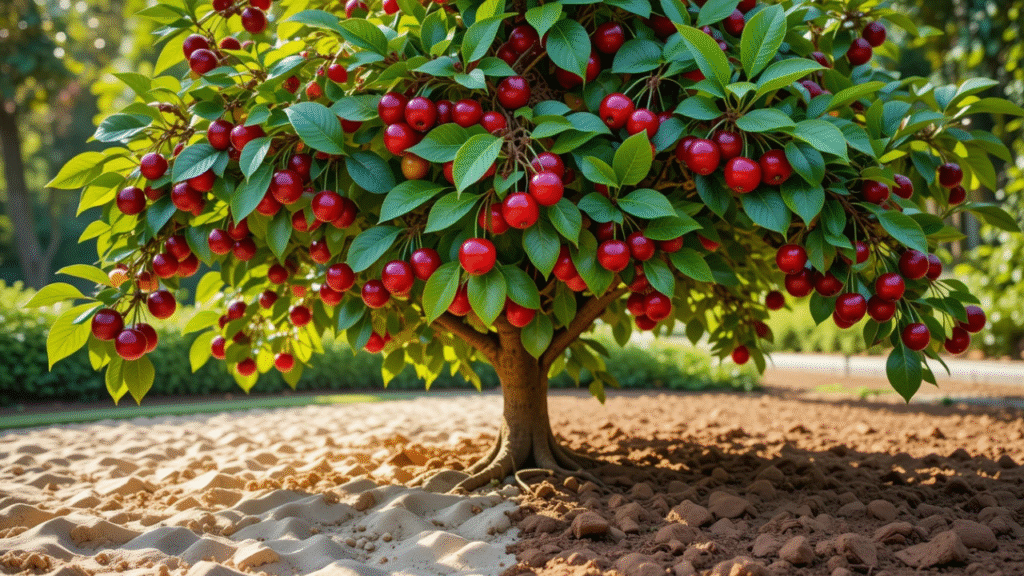
How to Grow Cherry Trees Successfully in Sandy or Clay Soils: Expert Tips for Thriving Trees
Are you struggling to grow cherry trees in sandy or clay soils? Don’t worry – you’re not alone! 🌍 Whether you have the quick-draining, nutrient-poor sandy soil or the heavy, compacted clay soil, both can present challenges for your cherry tree’s growth. But with the right techniques and care, it’s entirely possible to grow thriving cherry trees, no matter your soil type. In this article, we’ll share expert tips on how to grow cherry trees successfully in sandy or clay soils, helping you boost tree health and enjoy delicious fruit season after season! 🌳🍒
Table of Contents
Toggle🌱🌍 Understanding Sandy and Clay Soils 🌱🌍
Before diving into how to grow cherry trees, it’s important to understand the characteristics of sandy and clay soils. Each has unique qualities that can either help or hinder your tree’s growth.
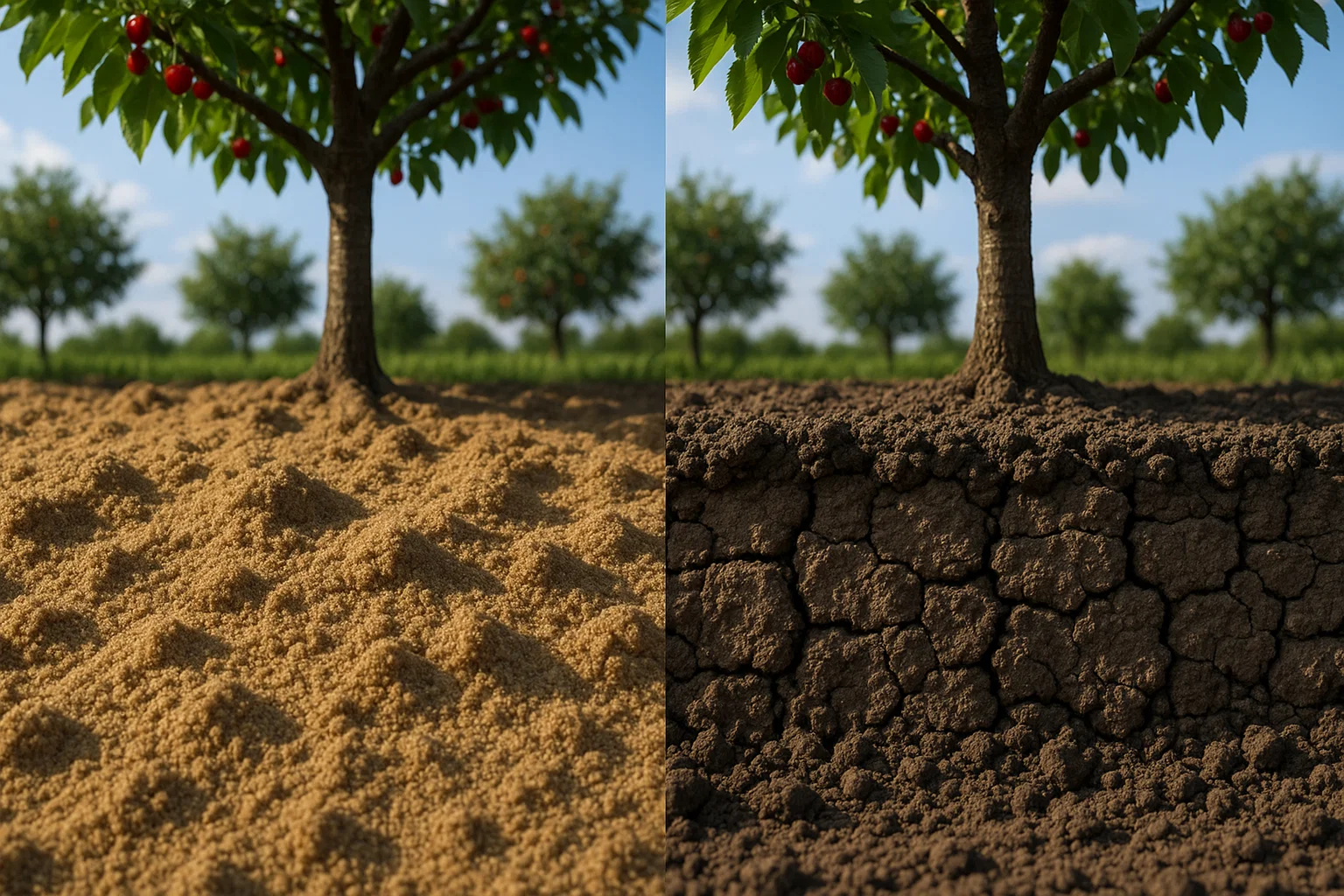
🏖️ Sandy Soils 🏖️
Key Characteristics:
Sandy soils are loose, light, and drain quickly. They don’t hold moisture well, which can cause your cherry tree’s roots to dry out if not properly managed.
Challenges:
The fast drainage means nutrients also wash away quickly, leaving your tree with less food. 🌧️
How It Affects Cherry Trees:
Sandy soil can be tricky because cherry trees need a steady supply of moisture and nutrients. Without proper amendments, they may struggle to grow and bear fruit.
🏞️ Clay Soils 🏞️
Key Characteristics:
Clay soils are dense and heavy. They retain water for longer periods, but they also struggle with drainage and can become compacted.
Challenges:
Clay soils often get waterlogged, which can suffocate the roots and lead to root rot. 🦠
How It Affects Cherry Trees:
While clay holds nutrients well, the lack of drainage can cause issues, especially during wet seasons, making it difficult for your cherry tree’s roots to get the oxygen they need to thrive.
By understanding these soil types, you’ll be better equipped to make the right changes that will allow your cherry trees to grow strong, healthy, and productive. For detailed guidance tailored to your soil, check out How to Grow Cherry Trees Successfully in Sandy or Clay Soils.🌳
🌱🔑 Soil Preparation: Key to Success 🌱🔑
Proper soil preparation is the foundation for growing healthy cherry trees in sandy or clay soils. Whether you’re dealing with fast-draining sand or dense clay, amending your soil before planting can make a world of difference. Here’s how to get started:
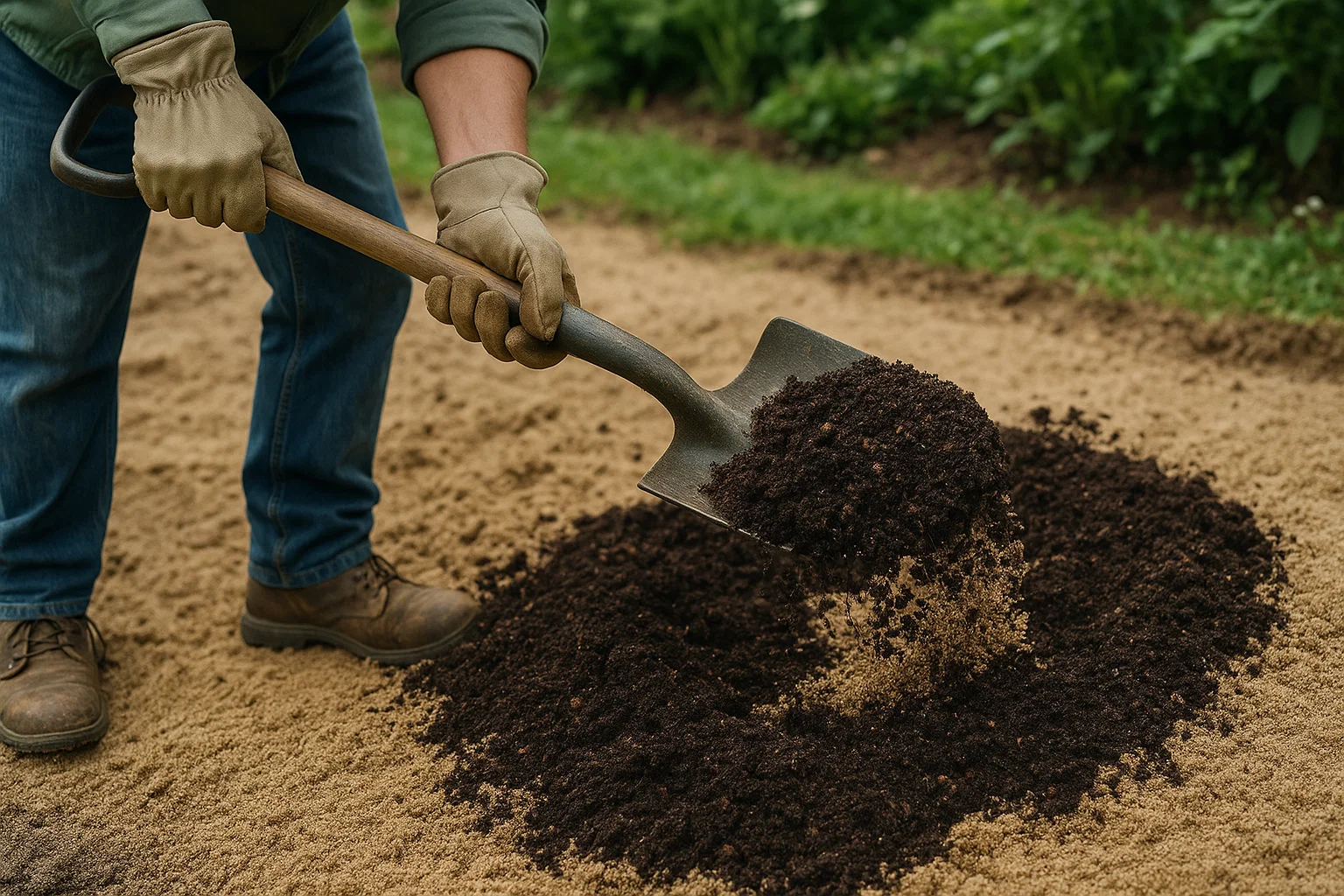
🌾 Improving Sandy Soils 🌾
What to Do:
Sandy soils need a little help to retain moisture and nutrients. Add organic matter like compost, well-rotted manure, or mulch to increase nutrient levels and improve moisture retention. 🌿
Why It Helps:
Organic matter improves soil structure by binding the particles together, helping to hold water and nutrients in place for your cherry tree’s roots.
How to Apply:
Mix 2-3 inches of compost or organic material into the top 6 inches of soil. This will create a more stable environment for root growth.
🌍 Improving Clay Soils 🌍
What to Do:
Clay soils need help with drainage to avoid waterlogging. Sand and organic matter are key here. Adding organic materials like compost or aged manure will loosen up the soil and improve drainage. 🏞️
Why It Helps:
Organic matter helps break up the dense particles, while sand prevents the soil from becoming too compact. Together, they allow water to flow more freely.
How to Apply:
Add 2-3 inches of compost or organic matter to the surface and mix it well into the top 6-8 inches of soil. If your clay soil is heavy, you may need to incorporate some sand, but use it sparingly.
📊 Check pH Levels 📊
Both sandy and clay soils can be too acidic or alkaline for cherry trees to thrive. Cherry trees prefer slightly acidic to neutral soil (pH between 6.0 and 7.0).
How to Check:
Use a simple soil test kit to check the pH.
How to Adjust:
- To raise pH (make soil more alkaline): Add lime.
- To lower pH (make soil more acidic): Add sulfur.
By taking these simple soil preparation steps, you’ll set the stage for your cherry trees to thrive, no matter whether you have sandy or clay soil. For a complete guide to soil-specific success, explore How to Grow Cherry Trees Successfully in Sandy or Clay Soils and give your trees the best possible start.🌳✨
🍒🌳 Selecting the Right Cherry Tree Varieties for Your Soil 🍒🌳
Choosing the right cherry tree variety is crucial when growing in sandy or clay soils. Different types of cherry trees have varying tolerances to soil conditions, and selecting the right one can make all the difference for your success. Here’s how to choose the best varieties for your soil:
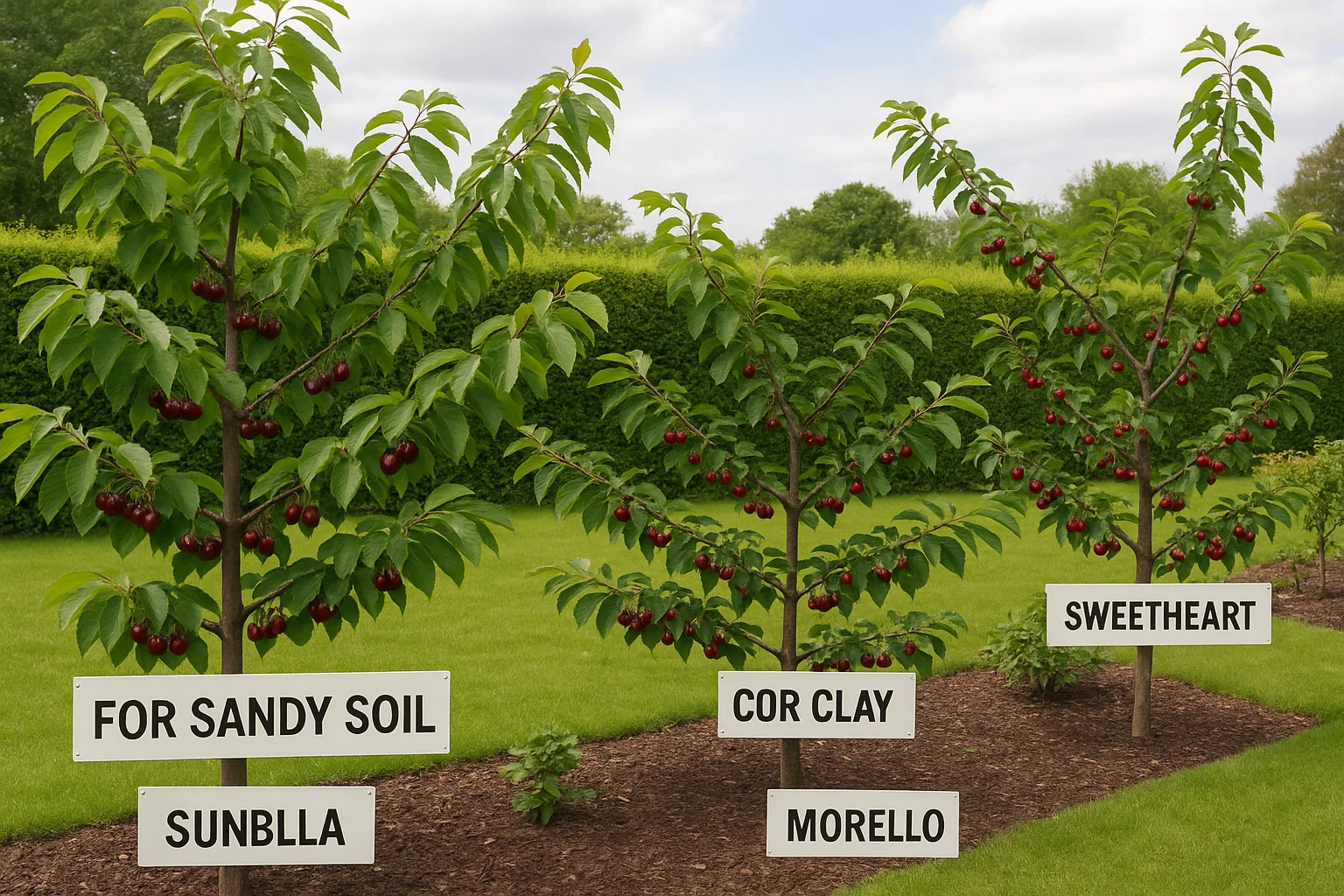
🏖️ Best Cherry Trees for Sandy Soils 🏖️
Sandy soils tend to be well-draining but can be nutrient-poor, so it’s important to choose varieties that can tolerate drier conditions and require less water retention.
Sweet Cherry Trees (e.g., Bing, Rainier):
These cherries do well in sandy soils as long as they have enough organic matter to retain moisture. Sweet cherry varieties also thrive in sunny locations and well-drained soils.
Dwarf Cherry Trees:
Smaller varieties like dwarf or semi-dwarf trees are ideal for sandy soils. They require less water and nutrients but still produce delicious fruit.
🏞️ Best Cherry Trees for Clay Soils 🏞️
Clay soils are nutrient-rich but can be too compact and prone to poor drainage. You’ll want varieties that can handle these conditions, especially those that need a bit more water and nutrient retention.
Tart Cherry Trees (e.g., Montmorency, Morello):
These varieties do better in clay soils because they tolerate a bit of excess moisture and are less susceptible to root rot compared to sweet cherries.
Hardy Cherry Varieties:
Some hardy cherry tree types are built to withstand heavier soils and fluctuating water levels. Look for varieties that are resistant to root rot and can tolerate slightly waterlogged conditions.
🌞❄️ Consider Local Climate and Hardiness Zones 🌞❄️
Climate Matters:
When choosing a variety, always consider your local climate. Some varieties are more suited for colder regions, while others thrive in warmer temperatures.
Hardiness Zones:
Check your area’s USDA hardiness zone to select a variety that will thrive in your environment.
🌿 Disease Resistance and Rootstock Selection 🌿
Disease Resistance:
Look for disease-resistant varieties that can handle potential soil-borne issues in clay soils, like root rot or fungal infections.
Rootstock:
Rootstock also plays a crucial role in how well a cherry tree will adapt to different soil conditions. For sandy soils, rootstocks that promote strong, deep roots are best. For clay soils, choose rootstocks that support better drainage and disease resistance.
By selecting the right cherry tree variety for your soil, you’ll set your trees up for success and ensure they thrive in their unique environment. To make the best choice based on soil conditions, refer to How to Grow Cherry Trees Successfully in Sandy or Clay Soils for expert recommendations. 🍒🌳
🌱🔨 Proper Planting Techniques 🌱🔨
Planting cherry trees correctly is essential to their long-term health and productivity, especially when dealing with sandy or clay soils. Here’s a guide on how to plant your cherry trees for the best start:
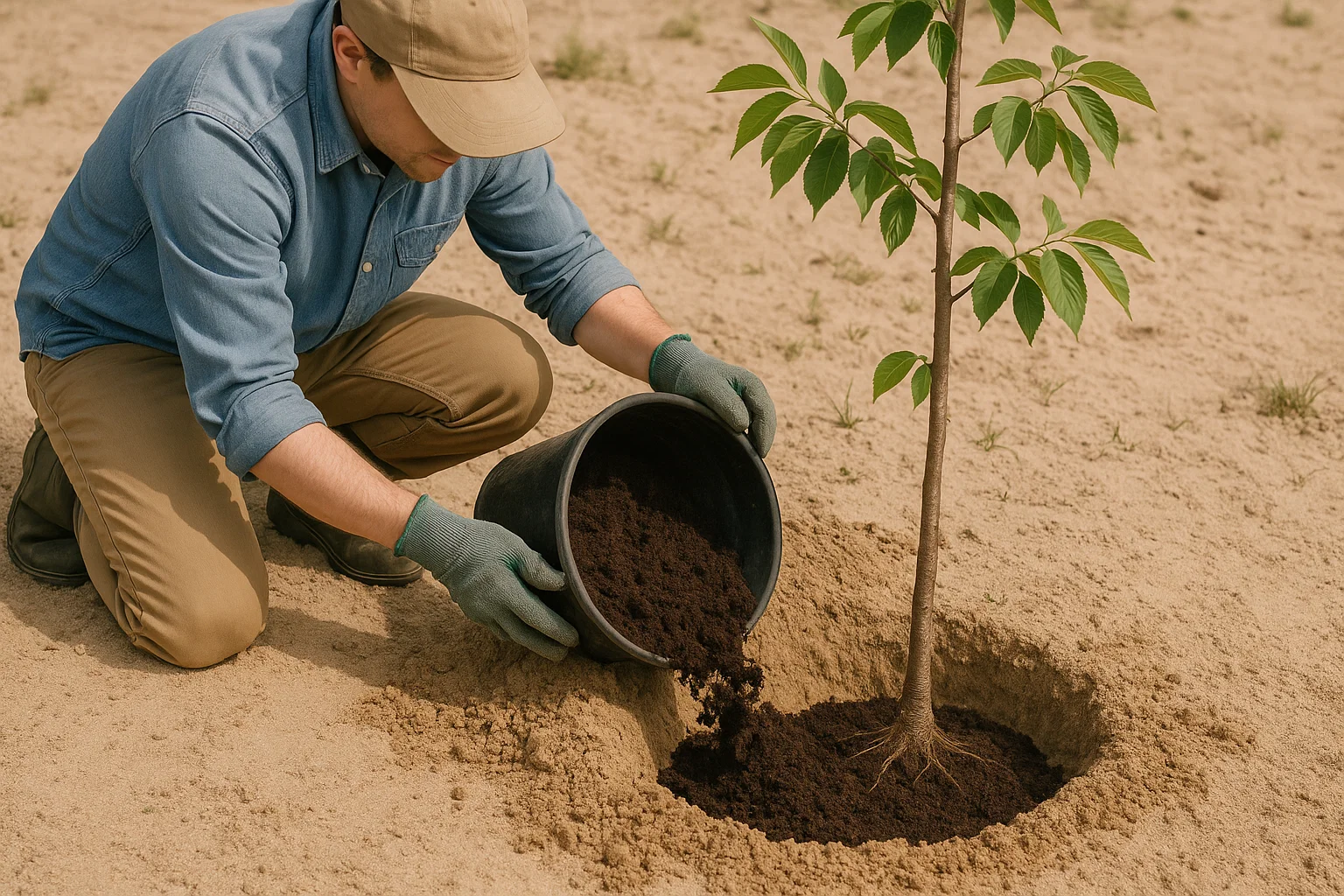
🏖️ Planting in Sandy Soils 🏖️
Sandy soils are well-draining but often nutrient-poor, so you’ll need to give your cherry tree extra care when planting.
Digging the Hole:
Dig a wide, shallow hole (about twice the size of the tree’s root ball) to allow the roots to spread out easily. 🌿
Amend the Soil:
Mix compost or organic matter into the sandy soil to improve moisture retention and nutrient content. This will help your tree’s roots establish a strong base. 💧
Planting Depth:
Position the tree so that the root flare (where the roots meet the trunk) is level with or slightly above the soil surface. This prevents water from pooling around the trunk, which can cause rot. 🌳
Watering:
After planting, water thoroughly to help settle the soil around the roots. Continue to water regularly, but avoid overwatering, as sandy soil drains quickly. 🌧️
🏞️ Planting in Clay Soils 🏞️
Clay soils are nutrient-rich but can become compacted and waterlogged, so it’s important to focus on improving drainage.
Digging the Hole:
Dig a slightly wider hole than the root ball to allow for good root expansion. Avoid digging too deep, as clay soil may retain too much water at lower depths. 🌍
Amend the Soil:
Add organic matter like compost or well-rotted manure to the clay soil to improve its structure and drainage. Mixing in some coarse sand will also help prevent compaction. 🌾
Planting Depth:
Ensure the root flare is level with the ground surface to avoid root suffocation. The soil around the tree should be firm but not compacted. 🌳
Watering:
Water deeply but infrequently to encourage deep root growth and avoid creating waterlogged conditions. 🌊
🌞 Spacing and Orientation 🌞
Spacing Between Trees:
Plant cherry trees far enough apart (about 15-20 feet) to ensure they have room to grow without overcrowding, allowing for proper air circulation and sunlight penetration. 🌞
Sunlight:
Cherry trees thrive in full sun, so choose a spot with plenty of direct sunlight (at least 6-8 hours per day). This is especially important for both sandy and clay soils to help your trees produce fruit.
🍂 Mulching for Protection 🍂
Mulch Layer:
Apply a 2-3 inch layer of mulch around the base of the tree (but not directly against the trunk) to help retain moisture, regulate soil temperature, and reduce weeds.
Benefits:
Mulch helps in sandy soils by keeping the moisture from evaporating too quickly, and in clay soils, it prevents water from pooling around the roots.
By following these proper planting techniques, your cherry trees will be off to a great start, with strong roots and the best possible conditions for growth, no matter whether you’re dealing with sandy or clay soils. 🌳🍒
💧🌱 Watering Tips for Different Soil Types 💧🌱
Watering your cherry trees correctly is crucial, especially when growing them in sandy or clay soils. Each soil type has different water retention properties, so understanding the best watering practices for each will ensure your trees stay healthy and hydrated.
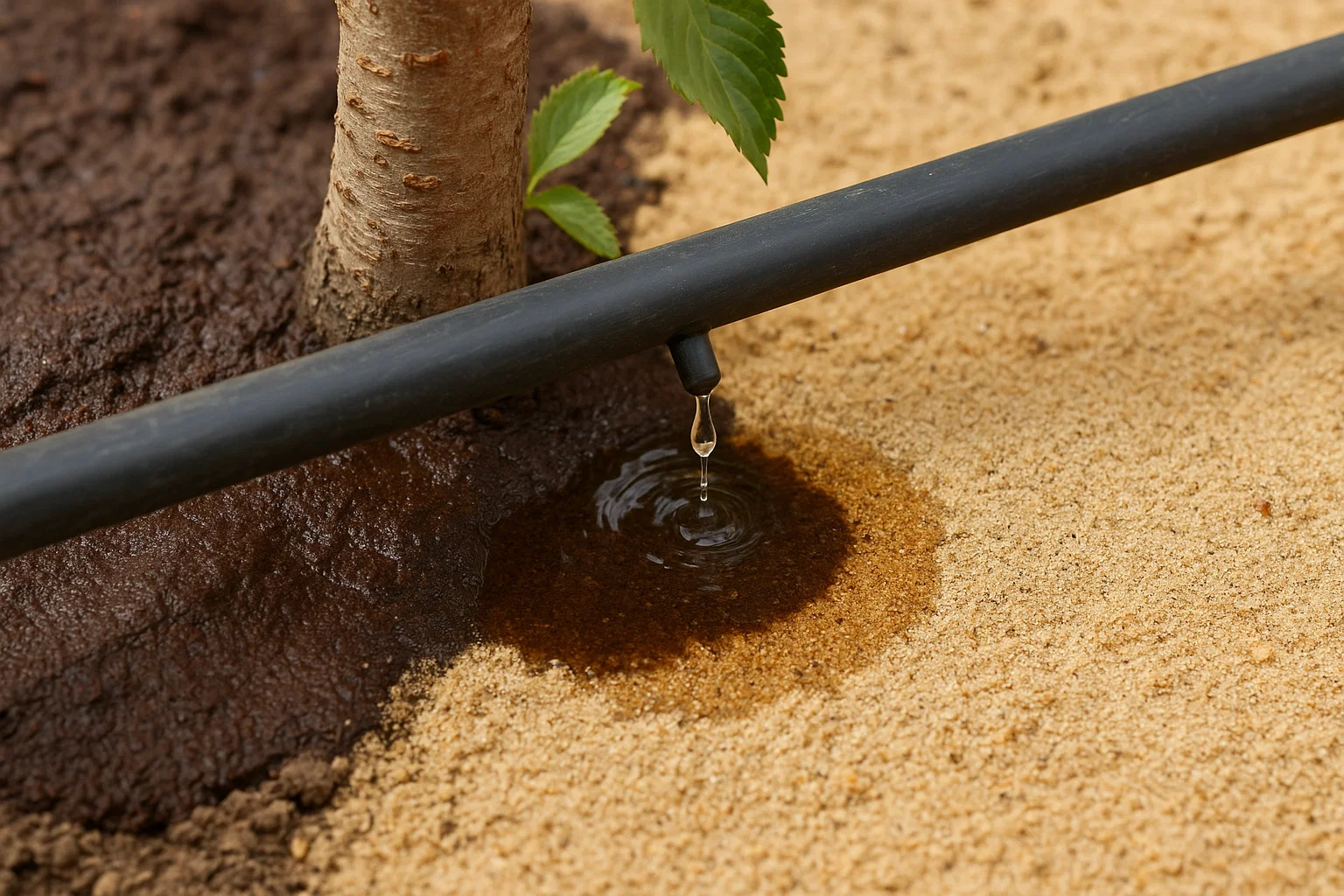
🏖️ Watering in Sandy Soils 🏖️
Sandy soils drain quickly, which means water doesn’t stick around long enough for your cherry tree’s roots to absorb it. Therefore, you need to water more frequently, but in smaller amounts.
Watering Frequency:
Sandy soil dries out faster, so it’s important to water your cherry trees more often — typically once a week, or more frequently during hot, dry weather. 🌞
Watering Depth:
Water deeply to ensure the moisture reaches the roots, but be careful not to flood the soil. Shallow, frequent watering can result in weak root systems. 💧
Watering Tips:
Use a drip irrigation system or a soaker hose to deliver water directly to the roots, preventing water wastage and minimizing evaporation. 🌱
🏞️ Watering in Clay Soils 🏞️
Clay soils retain moisture for a longer period but can become easily waterlogged, especially in heavy rainfall. Over-watering can cause the roots to suffocate, so proper watering techniques are key.
Watering Frequency:
Water less frequently, but deeply. Since clay holds moisture, you don’t need to water as often — about once a week or as needed, depending on rainfall and weather. 🌧️
Watering Depth:
Clay soils tend to compact, so watering deeply ensures moisture penetrates below the surface, encouraging deep root growth. Be cautious not to create puddles. 🌿
Watering Tips:
Avoid watering on heavy, rainy days, as the soil may already be saturated. Instead, water on dry days when the top layer of soil is dry, allowing it to absorb moisture properly. 🏞️
🌳💧 General Watering Tips for Both Soils 🌳💧
Morning Watering:
Water in the early morning to minimize water loss due to evaporation. Early watering also reduces the risk of fungal diseases. 🌅
Avoid Wetting the Leaves:
Focus on watering the base of the tree, rather than the leaves, to prevent diseases like powdery mildew and fungal infections. 🍃
Mulch to Retain Moisture:
Apply mulch around the base of your cherry tree to help maintain soil moisture, especially in sandy soils. It also helps to prevent the soil from drying out too quickly. 🌾
By following these watering tips based on your soil type, your cherry trees will get the hydration they need without over or under-watering, helping them thrive throughout the growing season. For more in-depth guidance on soil-specific care, explore How to Grow Cherry Trees Successfully in Sandy or Clay Soils. 🌳🍒
🌿🍒 Fertilizing Cherry Trees in Sandy or Clay Soils 🌿🍒
Fertilizing is crucial for the growth and fruiting of cherry trees, especially in sandy or clay soils. Each soil type requires specific attention to ensure your trees get the nutrients they need.
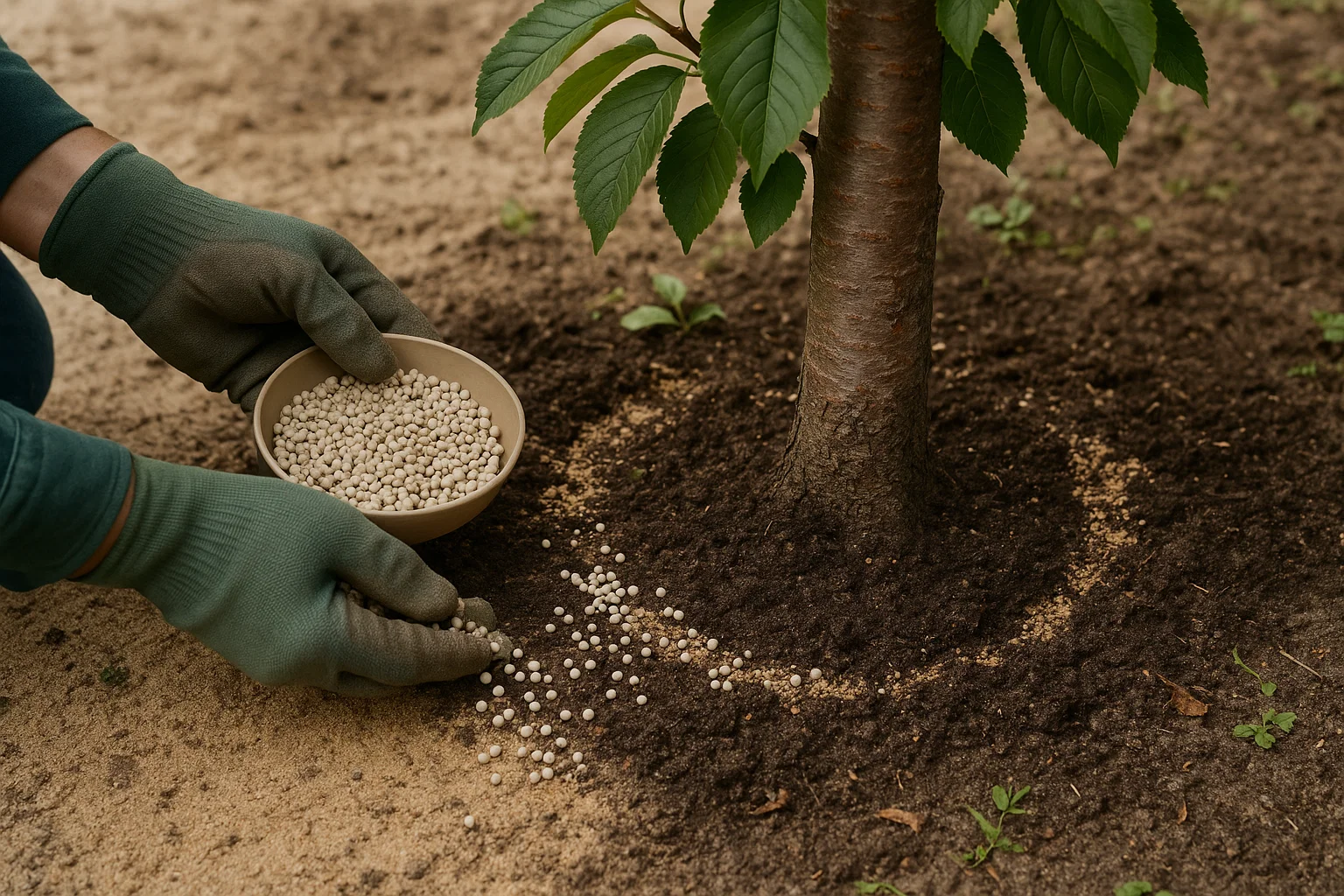
🏖️ Fertilizing in Sandy Soils 🏖️
Fertilizer Choice:
Use slow-release fertilizers (e.g., 10-10-10) or organic options like compost. These will provide nutrients over time, preventing them from washing away. 🌿
Application:
Apply in early spring before the growing season. Sprinkle the fertilizer around the base of the tree and water it in well. 💧
Nutrient Needs:
Sandy soils lack key nutrients like nitrogen, phosphorus, and potassium, so ensure your fertilizer has a balanced mix of these. 🌳
🏞️ Fertilizing in Clay Soils 🏞️
Fertilizer Choice:
Opt for organic fertilizers such as compost or fish emulsion. You can also use a balanced granular fertilizer for quicker results. 🌾
Application:
Apply in early spring as the tree starts to grow. Spread fertilizer evenly but not too close to the trunk. 🌳
Nutrient Needs:
Clay soils usually have sufficient potassium and phosphorus but may need extra nitrogen for healthy growth and fruiting. 🍒
🌞 When to Fertilize 🌞
Spring Feeding:
Apply fertilizer in early spring, just before the tree buds.
Fall Feeding:
A light fall application of organic fertilizer can help strengthen roots without promoting too much growth. 🍂
🌿💧 Organic vs. Synthetic Fertilizers 🌿💧
Organic Fertilizers:
Improve soil structure and provide long-term benefits, especially in sandy soils.
Synthetic Fertilizers:
Provide immediate results but don’t improve soil health over time. Use cautiously.
🍂 Mulching to Supplement Fertilizing 🍂
Mulch helps retain moisture in sandy soils, prevents compaction in clay soils, and adds nutrients as it decomposes. Apply 2-3 inches of mulch around the base of the tree (avoiding the trunk). 🌾
With the right fertilizer and timing, your cherry trees will thrive, whether you have sandy or clay soil! For tailored advice on soil conditions, check out How to Grow Cherry Trees Successfully in Sandy or Clay Soils and give your trees the best foundation.🌳🍒
✂️🌳 Pruning and Maintenance for Healthy Cherry Trees ✂️🌳
Pruning and proper maintenance are key to ensuring your cherry trees remain healthy, productive, and strong, especially in challenging sandy or clay soils. Here’s how to care for your cherry trees to keep them thriving year-round:
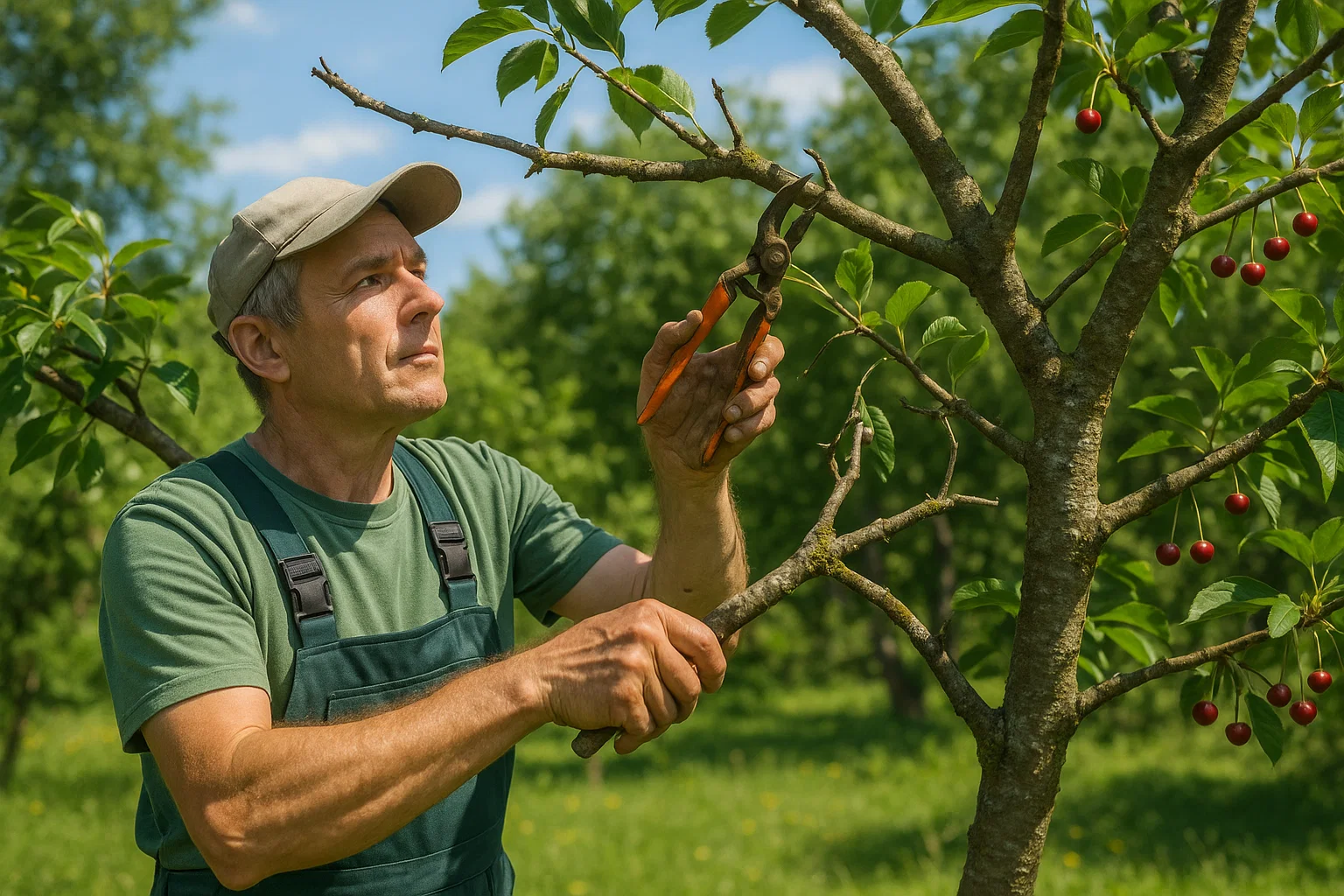
🍒✂️ Pruning Cherry Trees 🍒✂️
Why Prune?
Pruning encourages strong, healthy growth, improves air circulation, and helps prevent disease. It also shapes the tree, making it easier to harvest fruit.
When to Prune:
The best time to prune is during late winter or early spring, before the tree starts its new growth. Avoid pruning in the fall, as this can encourage new growth that may be damaged by frost. ❄️
How to Prune:
- Remove Dead or Diseased Wood: Cut back any dead, diseased, or broken branches to improve the tree’s health and airflow.
- Shape the Tree: Aim to maintain an open center with evenly spaced branches. This allows light to reach the inner parts of the tree and promotes better fruit production.
- Thin the Canopy: Thin out crowded branches to improve air circulation, which helps reduce the risk of fungal diseases. 🌿
- Cut at the Right Spot: Make cuts just above a bud or lateral branch to encourage new growth in the right direction.
🌱 Maintenance Tips for Healthy Cherry Trees 🌱
Watering:
Ensure your tree is well-watered, especially in dry periods. Adjust your watering based on whether you have sandy or clay soil (as discussed in previous sections). 💧
Mulching:
Keep a 2-3 inch layer of mulch around the base to retain moisture, control weeds, and improve soil structure. Avoid piling mulch directly against the tree’s trunk to prevent rot. 🌾
Fertilizing:
Follow the fertilizing schedule based on your soil type (sandy or clay). Fertilizing in spring and, occasionally, in fall will keep your tree nourished. 🌿
Pest and Disease Control:
Regularly check for pests like aphids, cherry slugs, or fungal diseases. Apply natural or organic treatments like neem oil to keep pests at bay. 🐞
🌳 Supporting Tree Growth 🌳
Staking Young Trees:
If your cherry tree is young, stake it for support, especially in windy areas. Use soft ties and adjust regularly as the tree grows to avoid damage.
Pruning for Structure:
As your tree matures, maintain a balanced structure. Cut back any crossing branches to avoid rubbing and prevent damage to the tree.
Regular pruning and maintenance ensure your cherry tree stays healthy and productive. By following these simple steps, you’ll enjoy better growth, fruit production, and overall tree health, no matter the soil type! 🌳🍒
🍒🔧 Common Problems and How to Solve Them 🍒🔧
Cherry trees, like any plant, can face a variety of challenges, especially when growing in sandy or clay soils. Understanding these common problems and knowing how to address them will keep your cherry trees healthy and thriving.
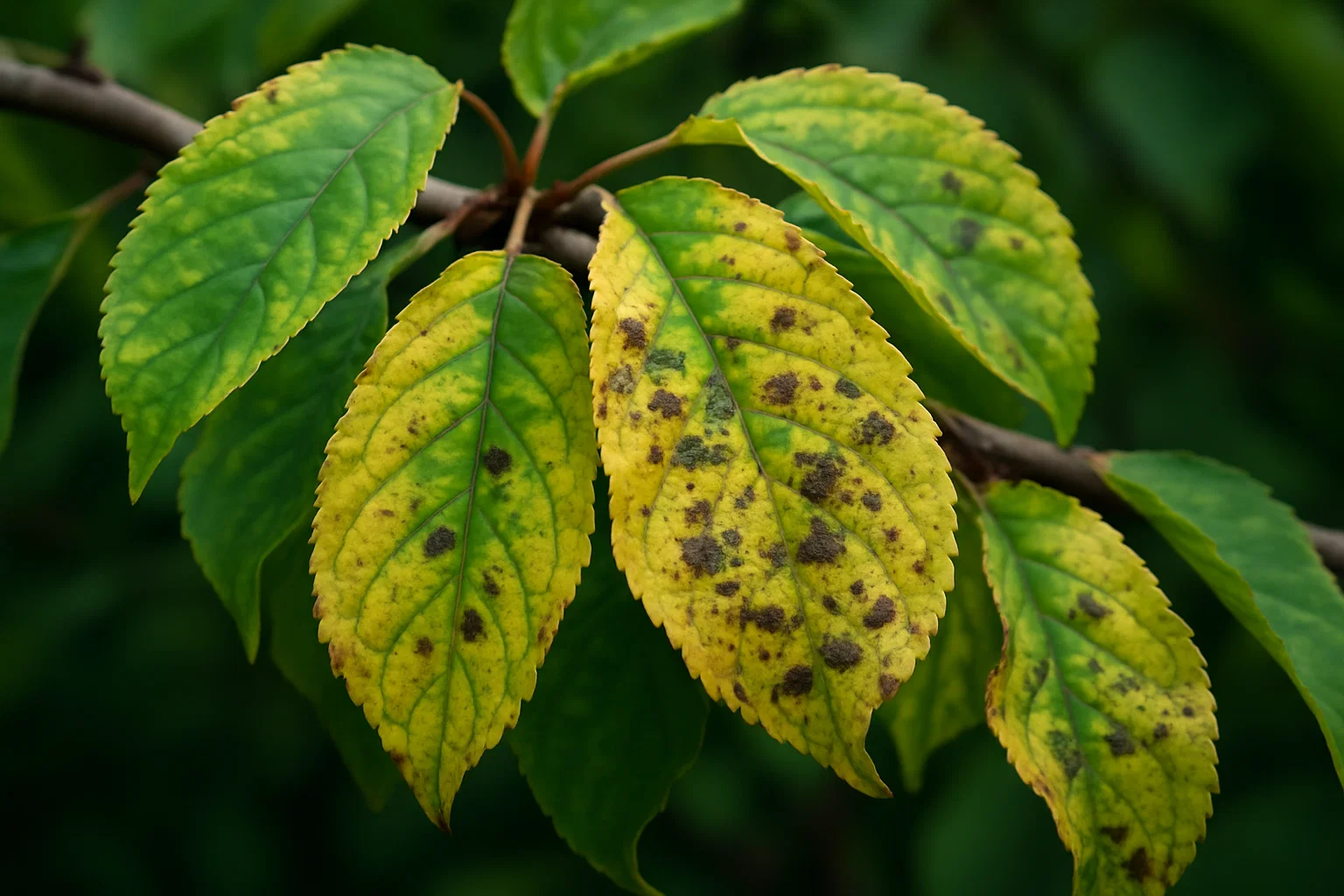
1. 🍂 Yellowing Leaves (Chlorosis) 🍂
Cause:
Yellowing leaves often indicate a nutrient deficiency, particularly a lack of nitrogen or iron. This is more common in sandy soils, which drain quickly and can wash away nutrients.
Solution:
- In sandy soils, use a balanced fertilizer with micronutrients, including iron.
- Apply a foliar spray of iron chelate if the tree is showing signs of iron deficiency.
- Consider adding organic compost to improve nutrient retention. 🌿
2. 🍒 Poor Fruit Production 🍒
Cause:
Low fruit production can result from improper pollination, poor soil nutrients, or improper pruning.
Solution:
- Ensure proper pollination by planting compatible cherry varieties nearby.
- Prune regularly to improve airflow and remove overcrowded branches.
- Fertilize appropriately (as discussed earlier), ensuring the tree has adequate nutrients for flowering and fruiting. 🌸
3. 🌊 Root Rot or Waterlogging 🌊
Cause:
Root rot occurs when the tree’s roots sit in overly wet conditions for too long, which can be a problem in clay soils that retain moisture.
Solution:
- Improve drainage in clay soils by adding organic matter like compost or coarse sand.
- Ensure you’re not overwatering your cherry tree, especially in clay soils.
- If you suspect root rot, carefully inspect the roots and trim away any damaged or diseased roots. 🌱
4. 🐛 Cherry Slug Damage 🐛
Cause:
Cherry slugs are pests that feed on cherry tree leaves, leaving behind a skeletonized appearance. They thrive in moist environments.
Solution:
- Hand-pick the slugs or use a strong jet of water to remove them from the tree.
- Apply organic insecticidal soap or neem oil to control infestations.
- Encourage natural predators like birds, which will eat the slugs. 🐦
5. 🌱 Fungal Diseases (e.g., Powdery Mildew) 🌱
Cause:
Fungal diseases like powdery mildew can appear when the tree is stressed from poor airflow, overwatering, or high humidity.
Solution:
- Ensure proper spacing between trees to improve air circulation.
- Prune any diseased leaves or branches and dispose of them properly (don’t compost).
- Treat with fungicide or organic alternatives like neem oil to control fungal outbreaks. 🌿
6. 🍃 Leaf Curl or Deformation 🍃
Cause:
This can result from insect damage, disease, or environmental stress. Insects like aphids can suck the sap from leaves, causing them to curl.
Solution:
- Inspect for pests such as aphids or scale insects, and treat with insecticidal soap or neem oil.
- Ensure your cherry tree is well-watered, especially in sandy soils, to prevent environmental stress. 💧
By staying proactive and addressing common problems early, your cherry trees can continue to grow and produce delicious fruit. Regular monitoring and timely interventions are the keys to solving issues and ensuring healthy, thriving trees! 🌳🍒
🌳🍒 Final Thoughts 🌳🍒
Growing cherry trees in sandy or clay soils can be a rewarding challenge when you understand the specific needs of each soil type. By following the expert tips on soil preparation, selecting the right cherry tree varieties, proper watering, and fertilizing, you’ll set your trees up for success. Regular pruning, maintenance, and addressing common problems will keep your trees healthy and productive.
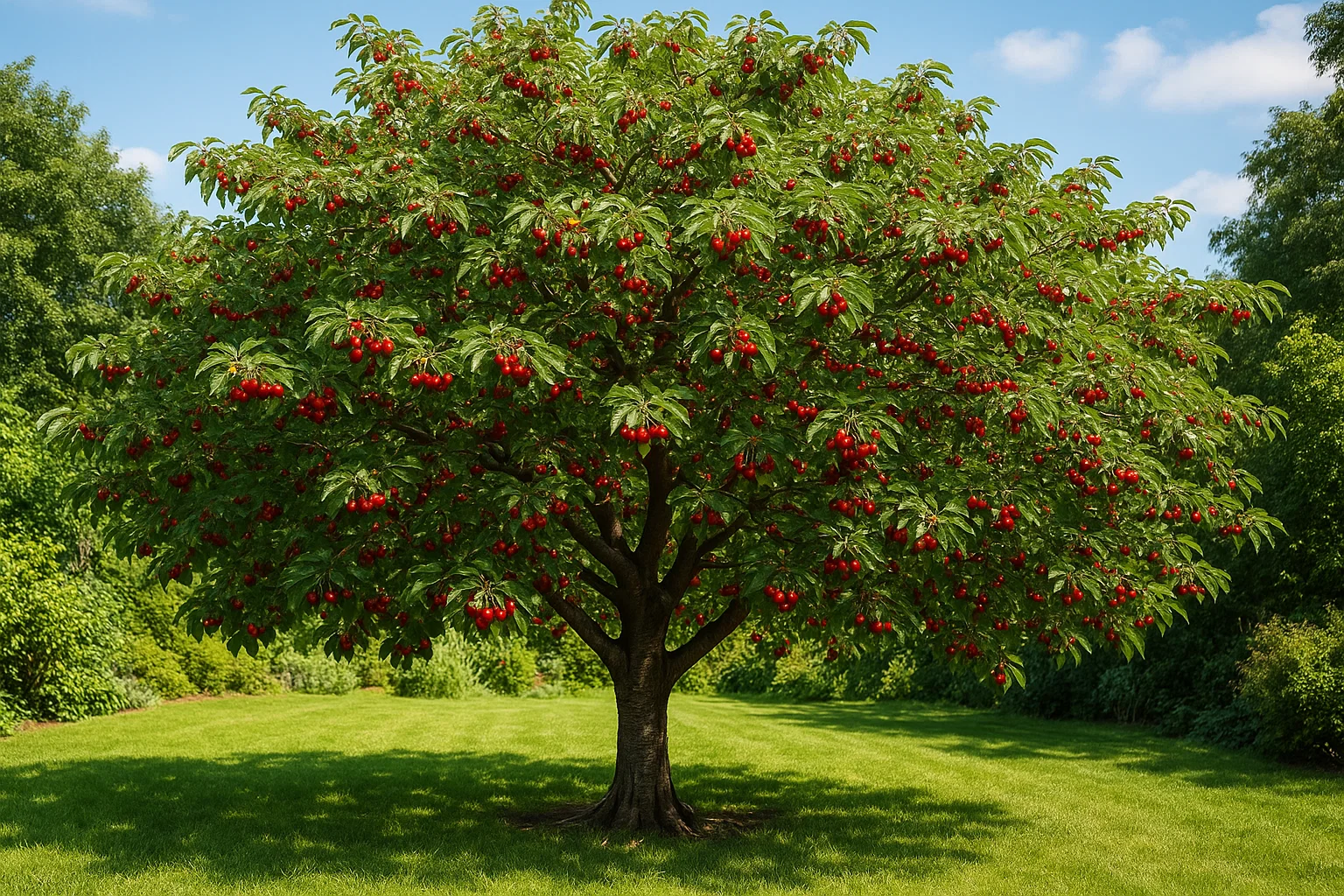
Remember, each cherry tree is unique, and nurturing it requires patience and care. With the right knowledge and practices, your cherry tree will reward you with beautiful blooms and delicious fruit year after year. For soil-specific guidance, explore How to Grow Cherry Trees Successfully in Sandy or Clay Soils to ensure optimal growth in challenging conditions.🌸🍒
Happy gardening, and may your cherry trees thrive! 🌿🌞
Frequently Asked Questions (FAQ)
Can Cherry Trees Grow in Sandy Soil?
Yes, cherry trees can grow in sandy soil, but they need proper care to thrive. Sandy soils drain quickly, so it’s essential to amend the soil with organic matter to retain moisture and provide nutrients.
Can Cherry Trees Grow in Clay Soil?
While clay soil holds nutrients well, it also retains water, which can lead to root rot. Cherry trees can grow in clay soil if the drainage is improved through soil amendments like compost or sand.
What Are the Best Soil Amendments for Cherry Trees in Sandy or Clay Soils?
For sandy soils, add compost or organic matter to improve water retention and nutrient content. For clay soils, mix in sand and organic matter to enhance drainage and root aeration.
How Can I Improve Soil Drainage for Cherry Trees?
To improve drainage, mix organic matter like compost, aged manure, or sand into the soil. For clay soils, adding coarse sand or building raised beds can help water flow better and prevent root suffocation.
What Type of Fertilizer Is Best for Cherry Trees in Sandy or Clay Soils?
A balanced fertilizer with equal parts nitrogen, phosphorus, and potassium works well for cherry trees in both soil types. For sandy soils, you may need to apply more frequent, lighter doses, while clay soils can benefit from slow-release fertilizers.
How Often Should I Water Cherry Trees in Sandy or Clay Soils?
Watering frequency depends on the soil’s moisture retention. Sandy soil dries out faster, so it may need more frequent watering. Clay soil retains water, so ensure it doesn’t become waterlogged. Always check the soil moisture before watering.
What Are the Signs That My Cherry Tree Is Not Thriving in Sandy or Clay Soil?
Yellowing leaves, wilting, stunted growth, or poor fruit production are signs that your cherry tree may not be getting the right nutrients or drainage. Soil testing can help identify specific deficiencies.
Can I Grow Cherry Trees in Poorly Drained Sandy or Clay Soil?
Cherry trees can survive in less-than-ideal soils, but they won’t thrive. Poorly drained soils, whether sandy or clay, can cause root rot and other issues. Improving soil structure and drainage is crucial for long-term success.
